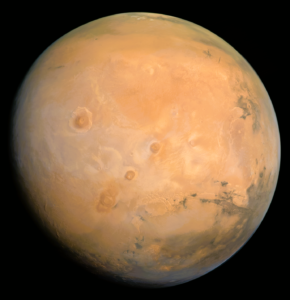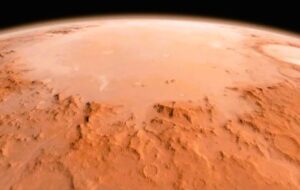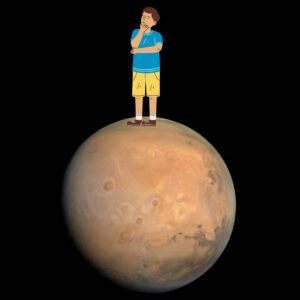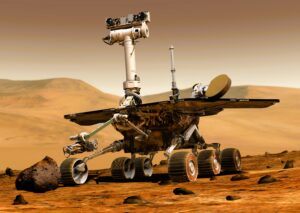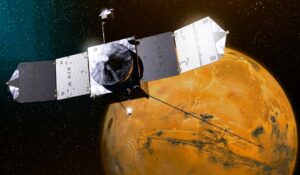- abaashishb7
- April 4, 2024
- 11:31 am
- No Comments
Mars Planet
मंगळ ग्रह
Mars | Exploration
Mars, often referred to as the “Red Planet,” is the fourth planet from the Sun in our solar
system. It is a terrestrial planet, sharing similarities with Earth such as a rocky surface,
polar ice caps, and a diverse range of geological features. this Planet has captivated
human curiosity for centuries, with its reddish hue visible to the naked eye in the night
sky.
* Discovery
Ancient Observations
1:- Prehistoric Times: Mars was visible to the naked eye, making it one of the five
planets visible from Earth without the aid of telescopes.
2:- Babylonian Astronomy: The Babylonians, around 3,000 years ago, were among the
first to record observations of Mars’ movements.
3:- Ancient Egyptians: The ancient Egyptians associated Mars with the god of war,
“Horus the Red.”
4:- Greek and Roman Mythology: In Greek and Roman mythology, This Planet was
associated with Ares and Mars, respectively, both gods of war due to its reddish
appearance.
Discovery of Mars’ Features
1:- Christiaan Huygens: In 1659, Huygens observed This PLanet’s polar ice caps and
correctly speculated that they were composed of water and carbon dioxide.
2:-Giovanni Cassini: In the late 17th century, Cassini observed This Planet’s rotation
period by tracking the movement of surface features.
19th Century Observations
1:- William Herschel: In the late 18th century, Herschel observed the planet’s polar ice
caps, equatorial dark markings, and seasonal changes.
2:- Percival Lowell: In the late 19th and early 20th centuries, Lowell made detailed
observations of Mars and famously believed he saw artificial canals, leading to
speculation about intelligent life on This Planet.
3:- Mars Oppositions: Astronomers used This Planet’s oppositions (when This Planet
is closest to Earth) to study its features more closely.
Space Age Discoveries
1:- Space Probes: In the mid-20th century, space probes provided close-up views of This
Planet.
2:- Mariner Missions: NASA’s Mariner missions in the 1960s and 1970s provided the
first close-up images of the Martian surface.
3:- Viking Missions: In 1976, NASA’s Viking 1 and 2 landers became the first spacecraft
to successfully land on Mars, conducting experiments to search for signs of life.
4:- Mars Rovers: Beginning with the Pathfinder mission in 1997 and followed by Spirit,
Opportunity, Curiosity, and Perseverance, NASA has sent rovers to explore the
Martian surface, providing valuable data about its geology and potential for past
habitability.
Current Understanding
1:- Recent Discoveries: Recent discoveries include evidence of ancient river valleys, lake
beds, and the presence of minerals that form in the presence of water, suggesting
this planet was once a wetter planet.
2:- Potential for Life: Mars’ history of water and the discovery of organic
molecules have sparked interest in the possibility of past microbial life on the planet.
3:- Future Exploration: Plans for future this planet exploration include sample return
missions, sending humans to this planet, and establishing potential colonies on the
Red Planet.
The discovery of Mars has evolved from ancient observations and mythology to
detailed scientific exploration. It continues to be a focal point for astronomers, planetary
scientists, and space agencies as we seek to unlock the mysteries of our neighboring
planet.
* Dimensions
Diameter
1:- Equatorial Diameter: Approximately 6,779 kilometers (4,212 miles)
2:- Polar Diameter: Approximately 6,752 kilometers (4,200 miles)
3:- Mean Diameter: The average diameter of This planet is about 6,779 kilometers
(4,212 miles)
Circumference
1:- Equatorial Circumference: Around 21,296 kilometers (13,258 miles)
2:- Polar Circumference: Around 21,229 kilometers (13,193 miles)
3:- Mean Circumference: The average circumference of this planet is approximately
21,229 kilometers (13,193 miles)
Surface Area
1:- Total Surface Area: Approximately 144.8 million square kilometers (55.9 million
square miles)
2:- Land Area: Mars has about 144.8 million square kilometers (55.9 million
square miles) of land area, since it doesn’t have oceans like Earth.
Volume
Total Volume: This Planet’s volume is approximately 1.63 x 10^11 cubic kilometers
(3.9 x 10^10 cubic miles)
Additional Measurements
1:- Gravity: Mars has about 38% of the gravity compared to Earth, meaning objects
weigh less on this planet than they do on Earth.
2:- Escape Velocity: The escape velocity on this planet is about 5.03 kilometers per
second (3.13 miles per second). This is the speed an object needs to achieve to
break free from this planet’s gravitational pull.
Comparison to Earth
This Planet is roughly half the size of Earth in diameter.
Earth’s equatorial diameter is about 12,742 kilometers (7,918 miles), making it
significantly larger than Mars.
Earth’s circumference at the equator is around 40,075 kilometers (24,901 miles), making
it approximately twice the circumference of Mars.
Understanding this planet’s dimensions helps scientists and astronomers compare it to
Earth and other planets, providing valuable insights into its geological and physical
characteristics.
* Key Fact
1:- Distance from the Sun: This Planet orbits the Sun at an average distance of about
227.9 million kilometers (141.6 million miles).
2:- Orbital Period: It takes this planet approximately 687 Earth days (1.88 Earth years)
to complete one orbit around the Sun.
3:- Day Length: A day on this planet, known as a “sol,” is approximately 24.6 hours.
4:- Size: This Planet has a diameter of about 6,779 kilometers (4,212 miles), roughly half
the size of Earth.
5:- Gravity: Gravity on Mars is about 38% of Earth’s, which means a person
weighing 100 kilograms on Earth would weigh about 38 kilograms on Mars.
Appearance
The distinct red color of This Planet is due to iron oxide (rust) on its surface, giving it a
reddish-brown hue. This iron oxide dust covers much of the planet’s rocky terrain,
creating a striking contrast with the darker regions.
Surface Features
1:- Volcanoes: Mars hosts some of the largest volcanoes in the solar system, such as
Olympus Mons, which is about 13.6 miles (22 kilometers) high.
2:- Canyons: Valles Marineris is a vast canyon system on This Planet, stretching about
2,500 miles (4,000 kilometers) long and up to 7 miles (11 kilometers) deep.
3:- Impact Craters: Like the Moon and Earth, This Planet is covered with impact craters,
some of which are well-preserved due to the planet’s relatively quiet geological
activity.
Atmosphere
Mars has a thin atmosphere composed mostly of carbon dioxide (95.3%), with traces of
nitrogen (2.7%) and argon (1.6%). Due to its thin atmosphere, the surface of Mars
experiences significant temperature variations, ranging from as low as -195 degrees
Fahrenheit (-125 degrees Celsius) at the poles to highs of 70 degrees Fahrenheit (20
degrees Celsius) in equatorial regions during summer.
Moons
Mars has two small moons named Phobos and Deimos. These moons are
irregularly shaped and are likely captured asteroids. Phobos is the larger of the two, with
an average diameter of about 22.4 kilometers (13.9 miles), while Deimos is smaller, with
an average diameter of about 12.4 kilometers (7.7 miles).
* Composition Of Mars
Surface Composition
1:- Iron Oxide (Rust): Mars’ most prominent feature is its reddish color, which
comes from iron oxide (Fe2O3) covering much of its surface.
2:- Basaltic Rock: Mars’ surface is predominantly made up of basalt, a type of
volcanic rock that forms from cooled lava flows.
3:- Silicates: Silicate minerals, such as olivine and pyroxene, are common on this planet
and make up a significant portion of its crust.
4:- Sulfur: This Planet’s surface also contains sulfur compounds, contributing to its
geological features.
Atmospheric Composition
This Planet’s atmosphere is much thinner than Earth’s, but it does have distinct
components
1:- Carbon Dioxide (CO2): The Martian atmosphere is about 95.3% carbon dioxide, which
contributes to its greenhouse effect.
2:- Nitrogen (N2): Nitrogen makes up about 2.7% of the atmosphere.
3:- Argon (Ar): Argon is present in Mars atmosphere at about 1.6%.
4:-Trace Gases: There are also trace amounts of water vapor, oxygen, methane, and
other gases.
Polar Ice Caps
1:- Water Ice: The Mars has polar ice caps composed mainly of water ice, with
some frozen carbon dioxide (dry ice).
2:- Carbon Dioxide (CO2): During Martian winters, the polar caps grow as carbon dioxide
freezes out of the atmosphere.
Mineralogical Composition
1:- Clays: This planet has clay minerals in its crust, indicating past water interaction.
2:- Sulfates: Sulfate minerals like gypsum have been identified on this planet,
suggesting past aqueous environments.
3:- Hematite: The presence of hematite, an iron oxide mineral, has been detected on this
planet, indicating water-related processes.
Atmospheric Dust
1:- Dust Particles: Mars’ thin atmosphere contains fine dust particles, which
contribute to the planet’s reddish hue.
2:- Dust Storms: These dust particles can be stirred up into massive dust storms that
cover large areas of the planet.
Importance of Composition
Understanding the composition of this planet is crucial for various reasons
1:- Planetary Evolution: It helps scientists understand the planet’s geological history and
evolution.
2:- Habitability: This Planet’s composition provides clues about its potential habitability
in the past and present.
3:- Exploration: Knowing the composition aids in planning missions, such as selecting
landing sites and analyzing samples.
* Structure Of Mars
Crust
1:- Thickness: The crust of this planet is estimated to be about 50 kilometers (31 miles)
thick on average.
2:- Composition: This Planet’s crust is primarily composed of basaltic rock, similar to
Earth’s oceanic crust.
3:- Surface Features: The crust is marked by various surface features, including impact
craters, volcanoes, and valleys.
Mantle
1:- Depth: The mantle of this planet extends from the crust to the core and is about
1,800 kilometers (1,118 miles) thick.
2:- Composition: The mantle is composed of silicate minerals, likely rich in iron and
magnesium.
3:-Heat Flow: This Planet’s mantle is not as active as Earth’s, with lower heat flow and
less tectonic activity.
Core
1:- Size: This Planet likely has a core with a radius of about 1,800 kilometers (1,118
miles).
2:- Composition: The core is believed to be primarily composed of iron and nickel.
3:- State: This Planet’s core is thought to have a solid inner core and a liquid outer core,
similar to Earth’s core.
Surface Features
1:- Volcanoes: This Planet has the largest volcano in the solar system, Olympus Mons,
which stands about 22 kilometers (13.6 miles) high.
2:- Valles Marineris: This is a system of canyons on This Planet, stretching about 4,000
kilometers (2,500 miles) long and up to 7 kilometers (4.3 miles) deep.
3:- Impact Craters: This Planet is covered with impact craters, some of which are well-
preserved due to its relatively inactive geological processes.
4:- Polar Ice Caps: This Planet has polar ice caps composed mainly of water ice, with
some frozen carbon dioxide.
Atmosphere
1:- Thickness: This Planet’s atmosphere is much thinner than Earth’s, with an average
pressure about 0.6% of Earth’s at sea level.
2:- Composition: This Planet’s atmosphere is primarily carbon dioxide (95.3%), with
nitrogen (2.7%), argon (1.6%), and trace amounts of other gases.
3:- Weather: This Planet experiences dust storms and variations in temperature due to
its thin atmosphere.
Importance of Mars’ Structure
Understanding the structure of This Planet is crucial for several reasons
1:- Geological History: This Planet’s structure provides insights into its geological
history, including past volcanic activity and tectonic processes.
2:- Potential for Life: Knowledge of This Planet’s structure helps scientists assess the
planet’s potential for supporting past or present life.
3:- Future Exploration: Understanding the internal structure aids in planning missions,
such as selecting landing sites and conducting seismic studies.
4:- Comparative Planetology: Comparing this planet’s structure to Earth’s helps
scientists understand the diversity of terrestrial planets in our solar system.
* What Would Happen if a Human Were to Enter Mars
If a human were to enter this planet without a spacesuit or proper protection, several
things would happen due to This Planet’s harsh environment and lack of a breathable
atmosphere. Here’s what would likely occur
Immediate Effects
1:- Lack of Atmosphere: This Planet has a very thin atmosphere, about 100 times less
dense than Earth’s. This means there would be essentially no air to breathe.
2:- Exposure to Vacuum: Without a spacesuit, the body would be exposed to the vacuum
of space once outside a spacecraft.
3:- Rapid Decompression: The body’s fluids (such as saliva, tears, and the water in the
body) would start to boil due to the low pressure, causing rapid decompression.
4:- Extreme Cold: This Planet’s average surface temperature is around -80 degrees
Fahrenheit (-62 degrees Celsius). The unprotected human body would quickly freeze.
Effects Within Seconds to Minutes
1:- Unconsciousness: Within about 15 seconds, the lack of oxygen would lead to loss of
consciousness.
2:- Hypoxia: Lack of oxygen would lead to hypoxia, which can cause brain damage and
death.
3:- Swelling and Bruising: The body would begin to swell slightly due to the lack of
external pressure.
4:- Tissue Damage: Exposed skin and eyes would freeze quickly due to the extreme cold.
Effects Within Minutes to Hours
1:- Death: Without immediate assistance, death would occur within a few minutes to
hours, mainly due to lack of oxygen and extreme cold.
2:- Freezing: The body would continue to freeze as temperatures drop further, causing
irreversible tissue damage.
3:- Lack of Oxygen: Cells in the body would begin to die from lack of oxygen, leading to
organ failure.
Long-Term Effects (If Somehow Rescued)
1:- Extreme Cold Injuries: If somehow rescued, the person would likely suffer from
severe frostbite and tissue damage.
2:- Brain Damage: Prolonged exposure to low oxygen levels can lead to brain damage.
3:- Internal Organ Damage: The lack of pressure and oxygen would have profound
effects on internal organs.
* Unique Characteristics
Reddish Color
1:- Iron Oxide: This Planet gets its distinctive red color from iron oxide (rust) covering
much of its surface.
2:- Surface: The red dust and rocks on This Planet give it a reddish-brown appearance,
visible from Earth.
Olympus Mons
1:- Largest Volcano: Olympus Mons is the largest volcano in the solar system, about 22
kilometers (13.6 miles) high and 600 kilometers (370 miles) in diameter.
2:- Shield Volcano: It is a shield volcano, formed by repeated eruptions of lava flows.
Valles Marineris
1:- Giant Canyon System: Valles Marineris is one of the largest canyons in the solar
system, stretching about 4,000 kilometers (2,500 miles) long, 200 kilometers (120
miles) wide, and up to 7 kilometers (4.3 miles) deep.
2:- Tectonic Activity: It is believed to have formed due to tectonic activity and possibly
volcanic processes.
Polar Ice Caps
1:- Water and CO2 Ice: This Planet has polar ice caps composed of water ice with layers
of frozen carbon dioxide (dry ice).
2:- Seasonal Changes: During Martian winters, the polar ice caps grow as carbon dioxide
freezes out of the atmosphere.
Phobos and Deimos
1:- Two Moons: This Planet has two small moons named Phobos and Deimos, which are
irregularly shaped.
2:- Captured Asteroids: These moons are likely captured asteroids, orbiting relatively
close to This Planet.
Thin Atmosphere
1:- Composition: This Planet’s atmosphere is thin, primarily composed of carbon dioxide
(95.3%), with nitrogen (2.7%) and argon (1.6%).
2:- Pressure: The atmospheric pressure on This Planet is about 0.6% of Earth’s at sea
level.
3:- Dust Storms: The thin atmosphere allows for massive dust storms that can cover the
entire planet for weeks.
Past Water
1:- Evidence of Rivers and Lakes: This Planet shows extensive evidence of ancient river
valleys, lake beds, and deltas.
2:- Minerals: Clay minerals and sulfates suggest past interactions with water, indicating
a wetter, warmer this planet in the past.
3:- Gullies: Recent observations have revealed gullies and features indicating recent
water activity.
Seasonal Changes
1:- Polar Frost: Seasonal frost appears at This Planet’s poles, expanding and retreating
with the changing seasons.
2:- Dust Storms: Seasonal dust storms occur, affecting visibility and temperature on the
planet.
Cold and Dry Environment
1:- Average Temperature: This Planet’s average surface temperature is about -80
degrees Fahrenheit (-62 degrees Celsius).
2:- Low Humidity: This Planet has very low humidity, making it an extremely dry
environment.
Potential for Life
1:- Past Habitability: This Planet’s history of water and the discovery of organic
molecules have sparked interest in the possibility of past microbial life.
2:- Subsurface Conditions: Some scientists theorize that life could exist below the
surface where conditions might be more hospitable.
* Modern Discoveries and Exploration
Modern discoveries and exploration of This planet have been driven by various robotic
missions sent by space agencies such as NASA, the European Space Agency (ESA), and
others. These missions have provided unprecedented insights into the Red Planet’s
geology, atmosphere, potential for past habitability, and the possibility of human
exploration in the future. Here are some notable modern discoveries and exploration
efforts
Mars Rovers
1:- Spirit and Opportunity (NASA, 2004): These rovers landed in different locations on
red planet and provided evidence of past water activity and the potential habitability
of ancient environments.
2:- Curiosity (NASA, 2012): The Curiosity rover has been exploring This Planet’s Gale
Crater since 2012, discovering evidence of an ancient lake bed and organic
molecules, further supporting the idea of a habitable environment in the past.
3:- Perseverance (NASA, 2021): Launched in 2020 and landed in 2021, Perseverance’s
primary mission is to search for signs of past microbial life, collect rock samples for
possible return to Earth, and pave the way for human exploration.
Insight Lander (NASA, 2018)
This stationary lander is studying the deep interior of This Planet, including seismic
activity and heat flow, providing insights into the planet’s geological activity and
structure.
Maven (NASA, 2014)
This Planet’s Atmosphere and Volatile Evolution (MAVEN) orbiter studies the Martian
upper atmosphere, helping scientists understand how Mars lost its early atmosphere
and water over time.
ExoMars (ESA and Roscosmos)
1:- Trace Gas Orbiter (TGO): This orbiter, launched in 2016, is studying the Martian
atmosphere and searching for traces of methane, a potential indicator of biological
activity or geological processes.
2:- Rosalind Franklin Rover: Planned for launch in the near future, this rover will search
for signs of past life, study the planet’s surface and subsurface, and collect samples.
Recent Discoveries
1:- Liquid Water Beneath the Surface: Radar data from Mars Express and ground-
penetrating instruments on Mars rovers have revealed evidence of liquid water
beneath the surface, possibly in the form of subsurface lakes.
2:- Organic Molecules: Various missions, including Curiosity, have detected organic
molecules on Mars, which are the building blocks of life.
3:- Methane Bursts: Seasonal variations in methane levels have been observed, leading
to speculation about potential geological or biological sources.
4:- Gullies and Seasonal Flows: Observations of gullies and recurring slope lineae
suggest the possibility of recent water activity on Mars.
Future Exploration
1:- Sample Return Missions: NASA and ESA plan to launch missions to collect samples
of Martian rock and soil, possibly as early as the 2020s, with the goal of returning
them to Earth for detailed analysis.
2:- Human Exploration: There are plans by various space agencies and private
companies, like SpaceX, to send humans to Mars in the coming decades, with the
goal of establishing a sustained human presence.
- abaashishb7
- April 4, 2024
- 11:31 am
- No Comments


